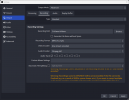The decibel (dB) scale is designed to show a wide range of values in a way that we can more easily relate to. It came out of the early telephone industry, as that was the first to really need it.
A lot of audio stuff came from the 'phone, by the way, like the standard 600-ohm impedance that we still use in pro gear today, being the characteristic impedance of two wires spaced apart on wood poles like they used to do. The gear and the standards were originally designed for that, and they stuck.
One Bel (named for Alexander Graham Bell) represents 10x the power. So 2 Bel is 100x, 3 Bel is 1000x, etc. Likewise for negatives: -1 Bel is 1/10, -2 Bel is 1/100, etc. The equation is
Bel = log10 ( measured / reference ).
As you might imagine, that's quite a large unit, so we use decibels (dB) instead. Now the equation is
dB = 10 * log10 ( measured / reference ).
And because there's a squared relationship between signal amplitude and the power that it causes, all else being equal, we need a different equation for signals to make the numbers match up:
dB = 20 * log10 ( measured / reference ).
(when you take the square out of a logarithm, it becomes a factor of 2)
Some other good things to know are:
- The logarithm of 1 is 0, regardless of whether it's base 10, base 2, base e, or whatever, so "no change" (
measured = reference) is 0dB.
- The logarithm of its own base is 1, which gives the definition above.
log10 ( 2 ) = 0.3 (almost), so 3dB is a factor of 2 in power. Half the power = -3dB, and is used a lot as an engineering threshold.- Because of the extra factor of 2 in the signal equation, 6dB is a factor of 2 in signal. So half the signal amplitude = -6dB.
- It's not exact, but we generally perceive 10dB (10x physical power) as a factor of 2 or so in our ears. Likewise for light in our eyes.
- The logarithm of 0 runs off to negative infinity, which we typically write as -inf or -oo. Any non-infinite negative dB may be small, but not gone yet.
By itself, dB is only a comparison, not an absolute level. When expressing a wide range of absolute levels, we often put a suffix on it to denote what reference we're using:
- dBV is referenced to 1 volt rms.
- dBm is referenced to 1 milliwatt.
- dBu is referenced to 1 "volume unit", which is the voltage required to push 1 milliwatt into 600 ohms, which works out to 0.7746 volts rms. The dBu scale is referenced to that voltage, regardless of what the load actually is.
- dBSPL (sound pressure level) is referenced to 20 micropascals rms in air, which is roughly the threshold of human hearing.
- dBA is dBSPL after applying an "A-weighting" filter, which discards most of the bass and some treble, leaving only the midrange that we're most sensitive to. This is not as useful as you (and policymakers) might think, because our hearing changes sensitivity to different frequencies based on level, and this measurement doesn't.
- dBC is the same thing but with a "C-weighting" filter instead, which brings back most of the bass but still ignores the treble.
- dB on an analog audio console is missing the required suffix, but it refers to the level that the designers want you to run the internal circuitry at.
- dBFS in digital audio refers to full-scale, or the maximum possible value that it can represent. Any higher than this AT ALL is clipped to that maximum (if it's well-behaved; poorly-behaved systems may "wrap" to the extreme opposite end of the scale and keep going from there, which sounds even worse)...but that only applies to integer formats, like the converter chips use in an audio console or your sound card.
- Floating-point formats, which the consoles and OBS use internally, set the value 1.0 as 0dBFS, which allows them to represent values much higher than that without clipping. If you think of the integer formats as not being integers at all, but fractions where the denominator is fixed at 2^n where n is the number of bits (so the maximum value is just short of 1), then you can flip the same value directly between "integer" and FP.
- Floating-point processing means that you can abuse a digital system far more than you can an analog one, and get away with it, but only if you reign it back in by the time it converts back to "integer" for the real-world output. Anything beyond FP +/-1.0 gets clipped to "integer" full-scale, and so it's still somewhat appropriate to label FP +/-1.0 as 0dBFS, like pretty much everything does, including OBS.
